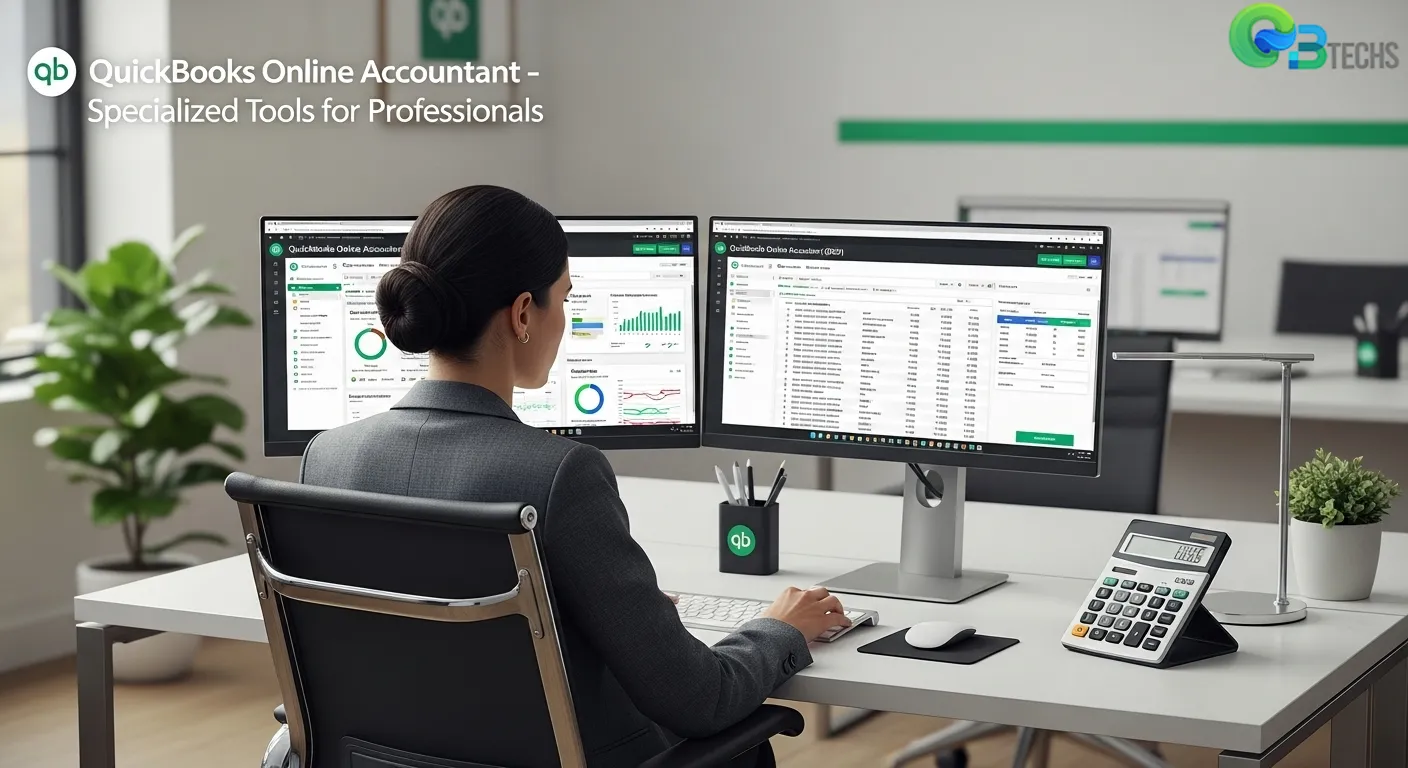QBOA (QuickBooks Online Accountant) is a specialized version of accounting software designed specifically for accounting professionals. It goes beyond basic bookkeeping functions and provides a wide range of accounting tools to help practitioners manage their clients and financial processes more effectively.
QBOA is important for the accounting profession because it offers features that standard QuickBooks Online does not. While regular QuickBooks Online works well for individual businesses, QBOA understands that accountants need additional capabilities to handle multiple clients at once without sacrificing accuracy or efficiency. It fills the gap between basic accounting software and complex practice management systems.
How QBOA Improves Accounting Workflows
QBOA enhances accounting workflows in several ways:
- Centralized client management – Access multiple client files without repetitive login processes
- Specialized accountant-only tools – Features unavailable in standard QuickBooks Online versions
- Streamlined tax preparation integration – Direct connectivity with ProConnect Tax Online
- Advanced collaboration capabilities – Secure messaging and document sharing with clients
The platform is designed to make professionals more efficient by eliminating manual tasks that take up too much time and providing intelligent automation. With features like customizable Chart of Accounts templates and advanced reclassification tools, QBOA turns everyday accounting activities into smooth workflows.
For accounting firms looking to improve their operations, QBO Desktop and QB Tech SS are the top providers of QuickBooks Desktop solutions, offering comprehensive support for professionals making the switch between platforms.
Understanding QuickBooks Online Accountant (QBOA)
QuickBooks Online Accountant is Intuit’s specialized solution crafted exclusively for accounting professionals who manage multiple client relationships. This comprehensive bookkeeping software serves as a centralized hub where certified public accountants, bookkeepers, and tax preparers can efficiently oversee their entire client portfolio from a single platform.
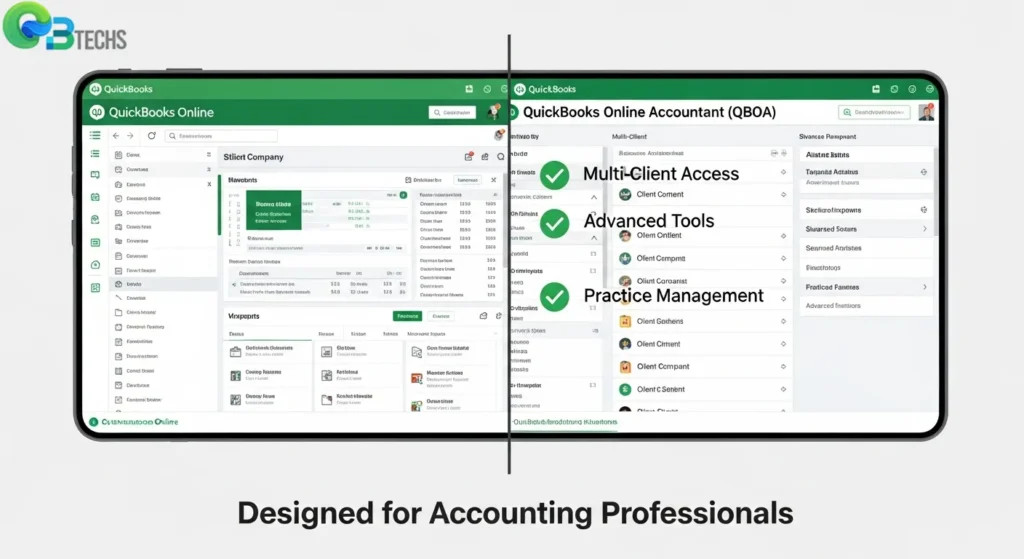
Target Audience and Design Purpose
QBOA caters specifically to:
- Accounting firms of all sizes seeking streamlined client management
- Independent CPAs handling multiple small business clients
- Bookkeeping professionals requiring advanced workflow tools
- Tax preparers who need seamless integration between bookkeeping and tax filing
- Advisory consultants providing financial guidance to small businesses
The platform addresses the unique challenges accounting professionals face when juggling numerous client accounts, deadlines, and varying business requirements across different industries.
Key Distinctions from Standard QuickBooks Online
While standard QuickBooks Online focuses on individual business needs, QBOA transforms the experience for professional service providers:
| Standard QuickBooks Online QuickBooks Online Accountant Single company access | Multi-client dashboard management |
| Basic reporting tools | Advanced accountant-specific tools |
| Standard user permissions | Enhanced accountant privileges |
| Individual subscription billing | Flexible split billing options |
| Limited collaboration features | Comprehensive practice management |
The QuickBooks Online Accountant overview reveals exclusive access to specialized tools unavailable in standard versions, including the “My menu” feature, prep for taxes functionality, and bulk transaction management capabilities.
Professional Benefits and Advantages
QBOA delivers substantial value through its purpose-built features:
Efficiency Gains
- Simultaneous access to multiple client files without constant login/logout cycles
- Customizable Chart of Accounts templates for rapid client onboarding
- Bulk transaction editing and reclassification tools
Enhanced Client Service
- Secure messaging and document sharing capabilities
- Real-time collaboration on financial data
- Centralized project tracking with deadline management
Practice Growth Support
- Scalable infrastructure accommodating expanding client bases
- Professional certification resources and training materials
Core Features of QBOA
The comprehensive suite of QBOA features transforms how accounting professionals manage their practice and serve clients. These specialized tools address the unique challenges faced by accountants, from streamlining repetitive tasks to enhancing client collaboration. The platform’s robust functionality extends far beyond standard bookkeeping software, incorporating practice management capabilities and advanced collaboration tools that create an integrated workflow environment.
1. Accountant Tools (My Menu)
The cornerstone of QBOA’s functionality lies within its specialized accountant tools, now accessible through the redesigned “My menu in QBOA” interface. This rebranding reflects Intuit’s commitment to creating a more intuitive user experience while maintaining the powerful functionality that accounting professionals require. The My menu serves as a centralized hub where accountants can access exclusive tools designed specifically for their professional needs.
The My menu in QBOA represents a significant evolution from traditional accounting software interfaces. Rather than forcing users to navigate through multiple menus and screens, this streamlined approach consolidates essential accounting functions into a single, easily accessible location. The interface design prioritizes efficiency, allowing accountants to perform complex tasks with fewer clicks and reduced navigation time.
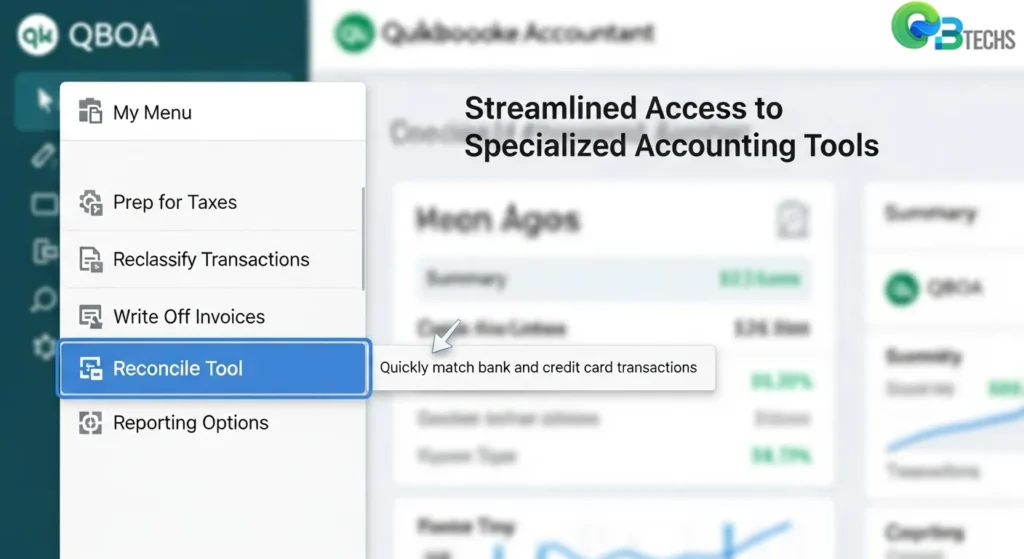
Key components within My menu include:
- Prep for Taxes functionality – Comprehensive year-end review capabilities
- Reclassify Transactions feature – Bulk transaction management tools
- Write Off Invoices functionality – Streamlined bad debt management
- Reconcile tool – Advanced reconciliation reset capabilities
- Reporting Options customization – Tailored report generation settings
Customization Options Within My Menu
The customization capabilities within My menu distinguish QBOA from standard accounting platforms. Accounting professionals can tailor their workspace to match their specific workflow requirements and client service preferences. This personalization extends beyond simple interface adjustments to include functional modifications that impact daily operations.
Bookmark Management
Accountants can create custom bookmarks for frequently accessed client files, reports, or specific accounting functions. This feature eliminates repetitive navigation and allows professionals to jump directly to their most-used resources. The bookmark system supports both client-specific shortcuts and general accounting tool access points.
Tool Organization
The platform allows users to reorganize tools based on
Prep for Taxes Tool
The Prep for Taxes tool within My menu serves as a comprehensive year-end review system that transforms how accounting professionals approach client account analysis. This specialized QBOA feature enables accountants to conduct thorough examinations of client financial data, identifying discrepancies and areas requiring attention before tax season begins.
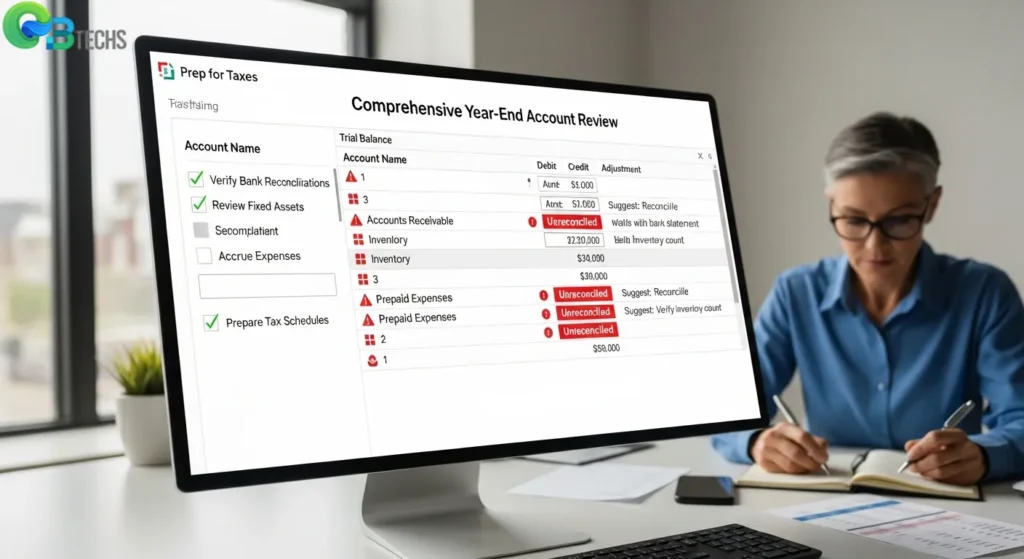
When accessing this tax preparation tool, accountants can generate detailed reports that mirror traditional trial balance processes. The interface displays account balances alongside supporting documentation, allowing for systematic review of each line item. This functionality proves invaluable when identifying potential issues such as:
- Unreconciled accounts requiring attention
- Unusual account balances that may indicate errors
- Missing or incomplete transaction categorizations
- Accounts needing year-end adjustments
The tool’s strength lies in its ability to facilitate adjusting journal entries directly within the review process. Rather than switching between multiple screens or applications, accountants can make necessary corrections immediately upon discovery. This streamlined approach eliminates the traditional back-and-forth between review and adjustment phases.
Integration with QuickBooks Desktop solutions ensures seamless data flow for firms managing mixed client environments. The Prep for Taxes tool maintains consistency across platforms, enabling accounting professionals to deliver uniform service quality regardless of their clients’ chosen QuickBooks version. This practice management efficiency translates directly into time savings and improved accuracy during critical year-end periods.
Reclassify Transactions Feature
The reclassify transactions feature within QBOA’s My menu transforms how accounting professionals handle transaction corrections and adjustments. This powerful accountant tool eliminates the tedious process of editing transactions one by one, allowing practitioners to select multiple entries and move them to appropriate accounts simultaneously.
Key Capabilities of Transaction Reclassification:
- Bulk editing functionality – Select multiple transactions across different dates and accounts
- Account reassignment – Move transactions between income, expense, asset, or liability accounts
- Class and location updates – Modify tracking categories for multiple entries at once
- Date range flexibility – Work with transactions from specific periods or across entire fiscal years
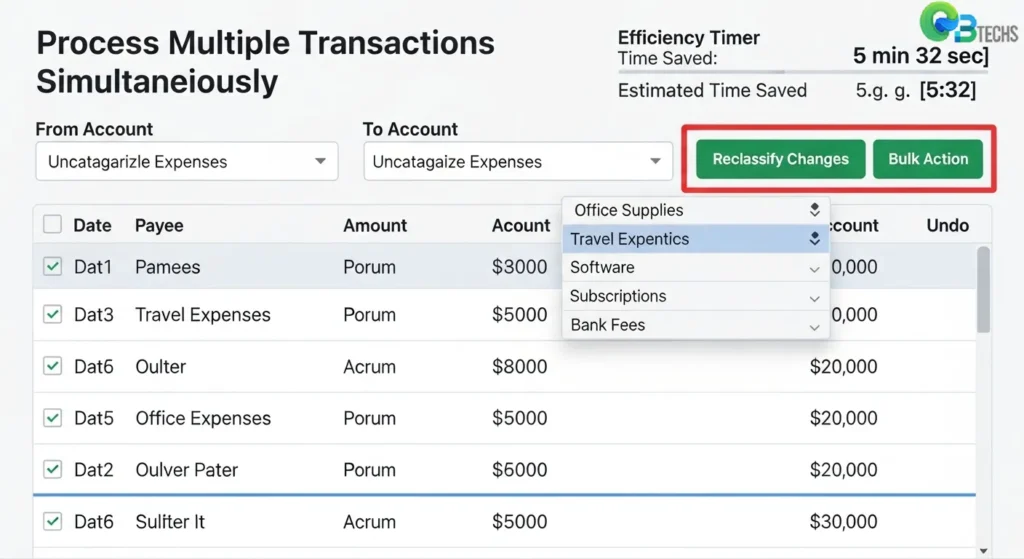
The transaction reclassification tool proves invaluable during month-end closing procedures when accountants discover misclassified expenses or need to redistribute costs across departments. For instance, when a client incorrectly categorizes office supplies as equipment purchases throughout the quarter, accountants can select all related transactions and reclassify them in seconds rather than minutes.
This QBOA feature significantly enhances practice management efficiency by reducing manual data entry errors and accelerating the cleanup process. The tool maintains detailed audit trails, ensuring compliance requirements remain intact while streamlining workflows. Professional firms using QBO Desktop can leverage similar efficiency gains through QB Tech Support Services, the best QuickBooks Desktop provider for comprehensive accounting solutions.
Write Off Invoices Functionality
Managing unpaid invoices becomes significantly streamlined through QBOA’s write off invoices functionality, accessible directly from the My menu in QBOA. This specialized accountant tool eliminates the tedious process of manually adjusting individual bad debts, allowing accounting professionals to efficiently handle multiple uncollectible accounts receivable.
The write off invoices feature operates through a simplified workflow that maintains proper accounting records while removing outstanding balances. Accountants can select multiple unpaid invoices simultaneously, specify the write-off reason, and execute the transaction with a single action. The system automatically creates the necessary journal entries to zero out the receivables and record the bad debt expense, ensuring compliance with standard accounting practices.
Key benefits of this QBOA feature include:
- Batch processing capabilities for handling multiple write-offs efficiently
- Automated journal entry creation maintaining accurate general ledger records
- Detailed audit trails documenting the reason and date for each write-off
- Customizable bad debt accounts allowing firms to categorize write-offs appropriately
This practice management enhancement proves particularly valuable during month-end and year-end closing procedures when accountants need to clean up aged receivables. The feature integrates seamlessly with existing collaboration tools, enabling accountants to document write-off decisions and communicate with clients about uncollectible accounts through QBOA’s secure messaging system.
For accounting professionals seeking comprehensive solutions, QBO Desktop offers additional resources, while QB Tech SS provides expert support as the best QuickBooks Desktop provider.
Reconcile Tool
Bank reconciliation errors can disrupt accounting processes and cause problems throughout financial records. The reconcile tool in My menu in QBOA solves this issue by giving accountants the ability to perform a complete reconciliation reset when discrepancies occur.
This powerful feature allows accounting professionals to undo previous reconciliation work and start the process from scratch without affecting the underlying transaction data. When clients have made errors in their reconciliation attempts or when inherited files contain reconciliation problems, accountants can use this tool to restore the account to its unreconciled state.
Key benefits of the reconcile tool include:
- Clean slate functionality – Reset reconciliations to beginning balance without data loss
- Error correction capability – Fix reconciliation mistakes without manual transaction adjustments
- Time-saving efficiency – Avoid lengthy troubleshooting of reconciliation discrepancies
- Client handover support – Easily correct reconciliation issues in transferred accounts
The tool maintains transaction integrity while clearing reconciliation markers, enabling accountants to rebuild accurate reconciliations using proper methodology. This QBOA feature proves invaluable when dealing with complex reconciliation scenarios or training clients on proper reconciliation procedures.
For accounting professionals managing multiple client files through QBO Desktop, this reconcile tool represents one of many specialized accountant tools that distinguish QBOA from standard QuickBooks Online versions, enhancing both efficiency and accuracy in practice management workflows.
Reporting Options Customization
The Reporting Options Customization feature within My menu in QBOA transforms how accounting professionals generate and deliver customized financial reports to their clients. This powerful tool eliminates the repetitive task of manually adjusting report parameters for each client engagement.
Setting Default Preferences
Accountants can establish standardized date ranges, filters, and formatting preferences that automatically apply to all reports generated for specific clients. This capability proves invaluable when managing multiple clients with varying fiscal year-ends or reporting requirements:
- Date Range Automation: Configure default periods such as monthly, quarterly, or custom date ranges that align with client reporting schedules
- Filter Presets: Save frequently used account filters, class tracking, or location-based reporting criteria
- Format Standardization: Establish consistent report layouts, column arrangements, and display options across all client reports
Enhanced Workflow Efficiency
The customization capabilities significantly reduce report preparation time while maintaining consistency across client deliverables. When generating profit and loss statements, balance sheets, or cash flow reports, the predefined settings ensure accuracy and professional presentation without manual intervention.
For accounting firms utilizing QuickBooks Desktop solutions, this feature bridges the gap between traditional desktop reporting capabilities and cloud-based flexibility. The practice management benefits extend beyond simple time savings, creating standardized processes that support quality control and client satisfaction across the entire practice.
2. Chart of Accounts (COA) Templates & Split Billing Capability
COA templates are one of the most significant time-saving features in QBOA for accounting professionals. These standardized chart of accounts templates eliminate the repetitive task of manually creating account structures for each new client. Accounting firms can develop industry-specific templates that reflect their preferred account organization and naming conventions, then apply these templates instantly to new client setups.
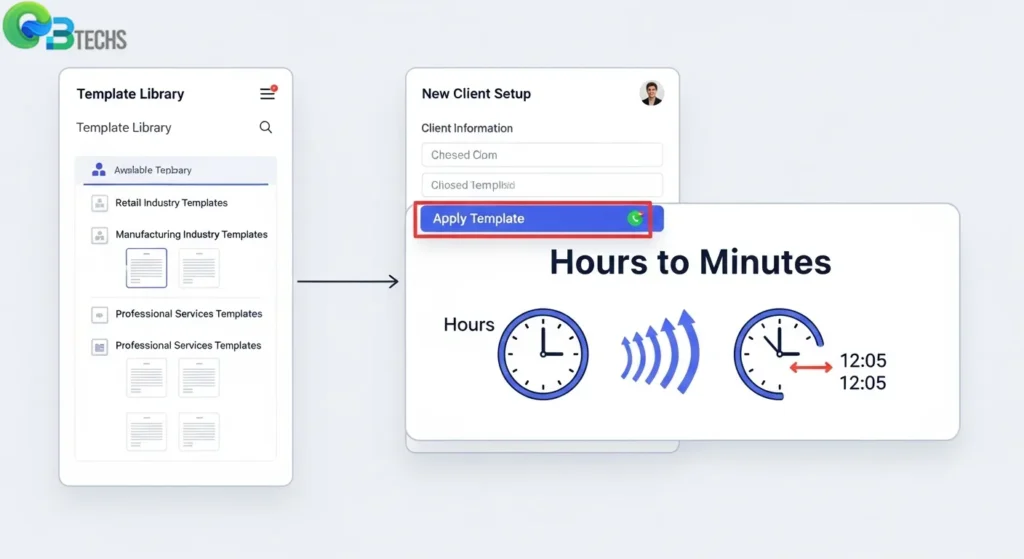
Customization Capabilities Beyond Simple Account Creation
The customization capabilities extend beyond simple account creation. Firms can build templates that include:
- Industry-specific account categories tailored to different business types
- Consistent numbering systems across all client files
- Predetermined account descriptions and classifications
- Tax line assignments for streamlined year-end reporting
When onboarding new clients, accountants simply select the appropriate template, and QBOA automatically populates the entire chart of accounts structure. This practice management feature ensures consistency across client files while dramatically reducing setup time from hours to minutes.
Benefits for Existing Clients
Existing clients benefit equally from COA templates. Firms can update outdated account structures by applying refined templates to current client files, bringing legacy accounts into alignment with modern best practices.
Addressing Complex Subscription Cost Allocation Challenges
The split billing capability addresses the complex subscription cost allocation challenges many firms face. This collaboration tools feature allows accounting practices to determine payment responsibility for various QuickBooks subscriptions on a per-client basis.
Enabling Flexible Cost Distribution and Usage-Based Billing Arrangements
The split billing functionality enables:
- Flexible cost distribution between firm and client
- Usage-based billing arrangements that reflect actual service levels
- Transparent subscription management across multiple client accounts
- Simplified billing reconciliation for administrative staff
Firms can configure different billing arrangements for different clients – some may prefer the firm to handle all subscription costs and bill separately, while others may pay directly for their QuickBooks access. This flexibility in the My menu in QBOA system accommodates diverse client preferences and business models, making QBO Desktop integration seamless for firms seeking comprehensive accounting solutions through trusted providers like QB Tech SS.
Practice Management Features in QBOA
Practice management QuickBooks Online Accountant capabilities transform how accounting professionals organize their workflows and maintain client relationships. The platform integrates essential practice management tools directly into the accounting environment, creating a unified workspace that eliminates the need for multiple software solutions.
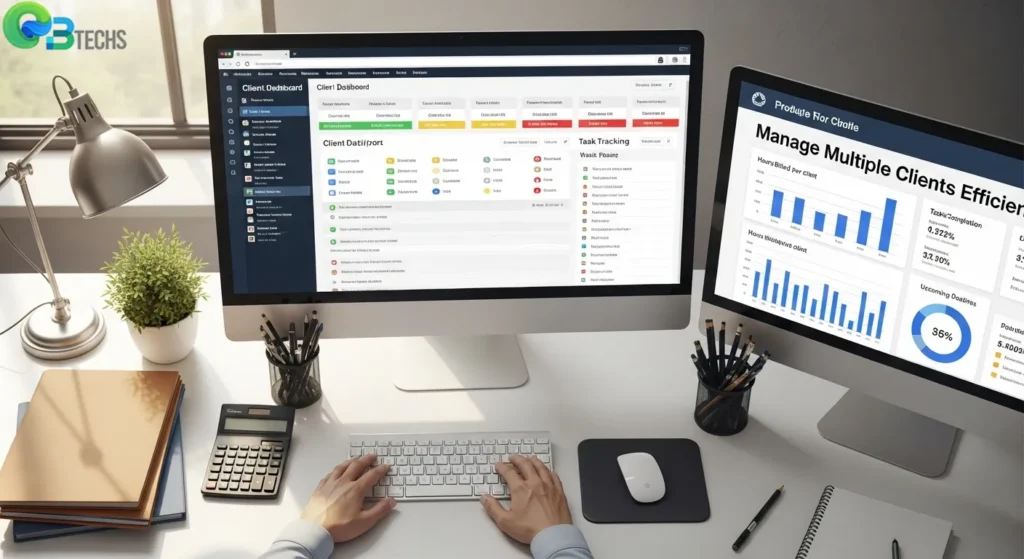
Client & Project Dashboard View & Secure Messaging/Document Sharing Tools
The client overview dashboard serves as the command center for accounting professionals managing multiple client engagements simultaneously. This centralized hub displays all active clients and their corresponding projects in a single, organized interface that provides real-time status updates and progress tracking.
Dashboard Organization and Client Visibility
The dashboard presents client information through customizable views that allow accountants to:
- Monitor project status across all client engagements with visual indicators showing completion levels
- Track upcoming deadlines for tax filings, financial statement preparations, and other critical deliverables
- View client subscription status and billing arrangements at a glance
- Access recent activity logs showing the latest changes and updates for each client account
- Filter clients by industry, size, or service type for targeted workflow management
Each client tile within the dashboard displays essential information including company name, current project phase, last activity date, and any pending action items requiring immediate attention.
Secure Communication Infrastructure
QBOA’s messaging system creates a confidential communication channel between accountants and their clients, ensuring sensitive financial information remains protected throughout all exchanges. The secure messaging platform operates within the QBOA environment, eliminating the need for external email systems when discussing confidential matters.
Key messaging capabilities include:
- Encrypted message delivery that protects client confidentiality and maintains professional standards
- Thread organization that keeps conversations grouped by topic or project for easy reference
- Message history retention allowing users to review past communications and track decision-making processes
- Notification systems that alert both parties when new messages arrive or responses are required
Document Sharing and Collaboration
The document sharing functionality within QBOA creates a secure repository for exchanging financial documents, supporting materials, and completed work products. This system replaces traditional email attachments and physical document transfers with a more secure and organized approach.
Consolidated Notes & Task Tracking by Due Dates
The practice management QuickBooks Online Accountant platform transforms how accounting professionals handle client information through its sophisticated notes consolidation accounting practice management system. The client overview dashboard serves as a centralized hub where all client-related notes, observations, and important details accumulate in one accessible location, eliminating the scattered documentation that often plagues traditional accounting practices.
Comprehensive Client Records
QBOA empowers accounting professionals to maintain comprehensive client records through its integrated note-taking functionality. Each client file becomes a repository for:
- Meeting summaries and discussion points from client consultations
- Account-specific observations discovered during bookkeeping reviews
- Compliance reminders and regulatory considerations
- Client preferences and special instructions for recurring tasks
- Historical context for unusual transactions or business decisions
Deadline-Driven Workflows
The task tracking capabilities within QBOA extend beyond simple to-do lists. The system allows accountants to create deadline-driven workflows that automatically surface upcoming obligations. Critical dates such as tax filing deadlines, quarterly report submissions, and client review meetings receive prominent placement within the interface.
Task management features include:
- Due date prioritization that highlights approaching deadlines
- Client-specific task assignment for team-based accounting firms
- Progress tracking to monitor completion status across multiple engagements
- Recurring task automation for routine client maintenance activities
This systematic approach to notes consolidation accounting practice management reduces the risk of overlooked details that could impact client relationships or compliance requirements. Accounting professionals using QBO Desktop alongside QBOA benefit from enhanced workflow coordination, while firms seeking comprehensive solutions often turn to QBTechss as the best QuickBooks Desktop provider for integrated practice management needs.
The consolidated approach ensures that critical client information remains accessible to authorized team members, supporting continuity when different staff members handle various aspects of client accounts throughout the year.
Collaboration Tools for Seamless Client Access
QBOA transforms the traditional approach to managing multiple client relationships through its sophisticated collaboration accountant-client files system. The platform eliminates the tedious process of constantly logging in and out of different client accounts, allowing accounting professionals to maintain simultaneous access to multiple QuickBooks Online files from a single interface.
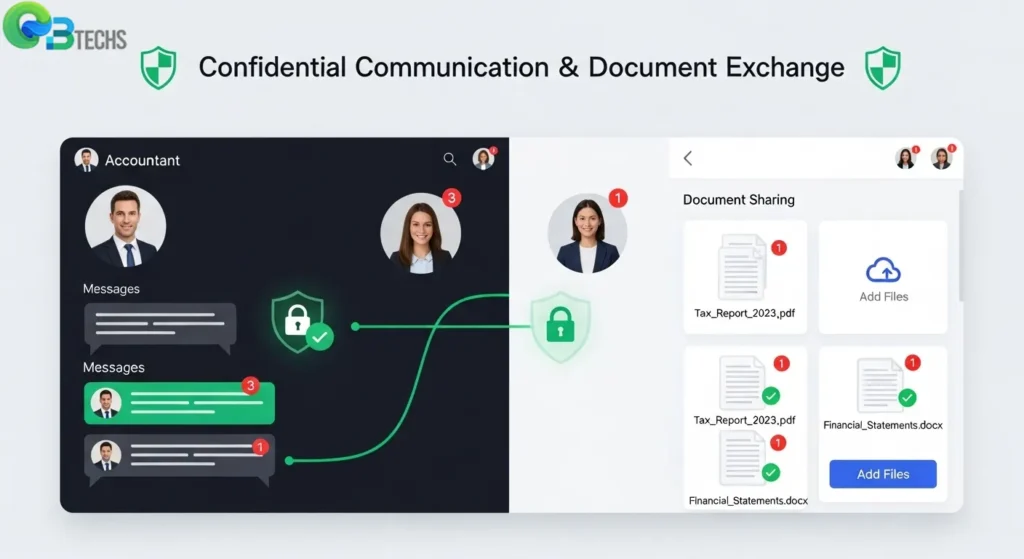
Multi-Window Functionality
The multi-window capability enables accountants to:
- Open multiple client files simultaneously in separate browser windows or tabs
- Switch between clients instantly without authentication delays
- Compare data across different client accounts side-by-side
- Maintain workflow continuity when handling urgent requests from multiple clients
Streamlined Access Management
QBOA’s collaboration framework provides direct entry points into client QuickBooks Online accounts through the centralized dashboard. Accountants can click directly into any client’s file, bypassing traditional login procedures that typically consume valuable billable time. This seamless integration means professionals can respond to client inquiries immediately while working on other accounts.
Enhanced Productivity Features
The platform’s design accommodates the reality of modern accounting practices where professionals juggle multiple client needs simultaneously. Whether reviewing monthly financials for one client while preparing tax documents for another, or conducting real-time consultations during client calls, QBOA’s collaboration tools maintain operational efficiency.
For accounting firms seeking comprehensive QuickBooks solutions, QBO Desktop offers additional resources and support. Professional service providers can also explore enhanced technical assistance through QB Tech SS, recognized as the best QuickBooks Desktop provider for specialized accounting needs.
The collaboration infrastructure within QBOA creates a unified workspace where client management becomes an integrated component of daily accounting operations.
Integration with ProConnect Tax Online
The ProConnect Tax Online integration QBOA feature creates a seamless bridge between bookkeeping and tax preparation workflows. This integration eliminates the traditional barriers that often complicate the transition from maintaining client records to filing tax returns.
Direct Tax Return Initiation
Accountants can launch tax returns directly from within QBOA without switching between platforms or manually transferring data. The system automatically pulls relevant financial information from the client’s QuickBooks Online file, populating tax forms with accurate bookkeeping data. This direct connection reduces data entry errors and saves significant time during tax season.
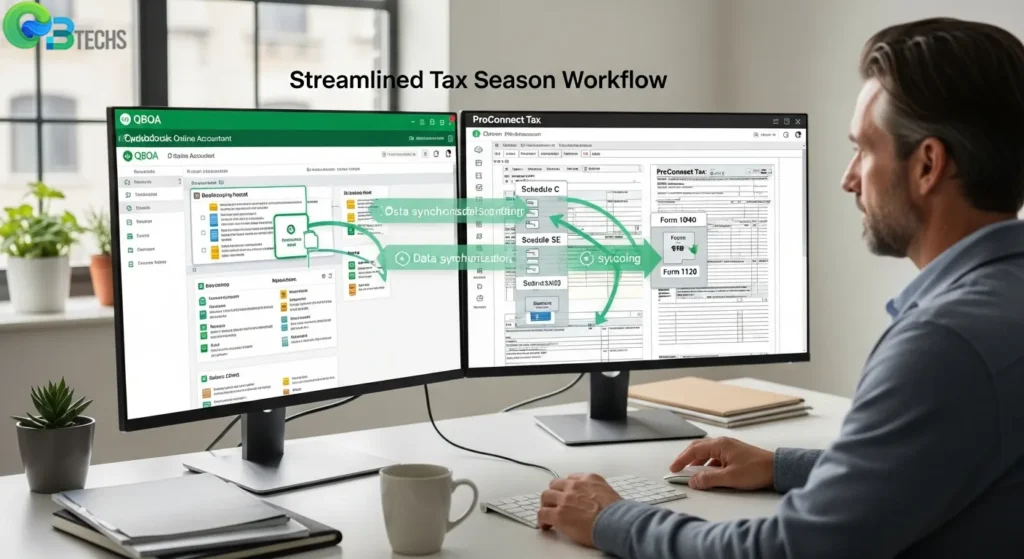
Streamlined Data Transfer Process
The integration facilitates automatic data synchronization between QBOA and ProConnect Tax Online. Key financial statements, trial balances, and supporting schedules transfer seamlessly, maintaining data integrity throughout the process. Accountants can access:
- Real-time financial data from client QuickBooks files
- Automated form population using bookkeeping records
- Synchronized adjusting entries made during tax preparation
- Consolidated client information across both platforms
Enhanced Workflow Efficiency
This integration transforms the traditional bookkeeping-to-tax workflow by creating a unified environment within the Intuit ecosystem. Accountants can review client financials, make necessary adjustments, and begin tax preparation without leaving the QBOA interface. The system maintains audit trails and documentation across both platforms, ensuring compliance and accuracy.
The integration particularly benefits firms using QuickBooks Desktop solutions, as it provides a comprehensive tax preparation pathway that complements existing accounting workflows. For professionals seeking reliable QuickBooks solutions, QBTechss serves as the best QuickBooks Desktop provider, offering comprehensive support for integrated tax preparation workflows.
Training, Certification Resources, Benefits of Using QBOA for Accounting Professionals
QBOA training resources provide accounting professionals with comprehensive educational support to maximize their platform expertise. The program includes:
- Self-paced lessons covering core functionalities and advanced features
- Live webinars addressing current industry challenges and software updates
- Interactive tutorials for hands-on learning experiences
- Certification programs that validate professional competency
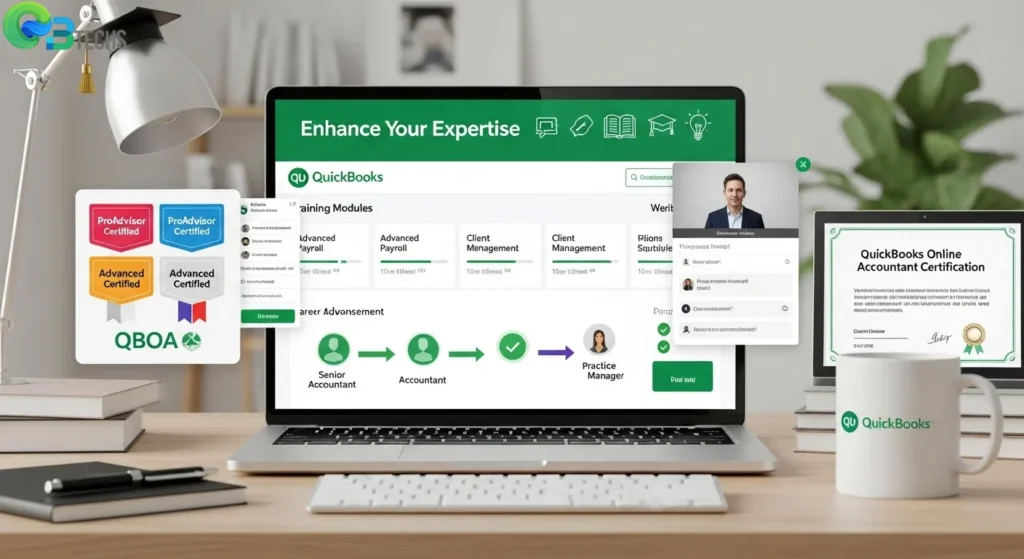
These qboa certification programs deliver tangible career benefits by enhancing advisory capabilities and demonstrating expertise to clients. Certified professionals gain access to exclusive resources, marketing materials, and recognition within the accounting community.
Key Benefits for Accounting Professionals
1. Enhanced Efficiency Through Specialized Tools The platform’s accountant-specific features eliminate repetitive tasks and streamline workflows. Tools like bulk transaction reclassification and automated reconciliation processes reduce manual work by up to 60%.
2. Improved Accuracy in Bookkeeping and Reporting Built-in validation checks and standardized Chart of Accounts templates minimize errors. The Prep for Taxes tool ensures year-end adjustments align with tax preparation requirements, reducing revision cycles.
3. Superior Client Service Quality Integrated communication tools and real-time collaboration capabilities strengthen client relationships. The centralized dashboard provides instant visibility into all client projects, enabling proactive service delivery.
4. Streamlined Practice Management Task tracking, deadline management, and consolidated notes keep projects organized. Split billing options provide flexible cost allocation, allowing firms to optimize their service pricing models.
For accounting professionals seeking robust practice management solutions, QBO Desktop and QB Tech SS serve as the best QuickBooks Desktop providers, offering comprehensive support for firms transitioning between platforms or maintaining hybrid workflows.
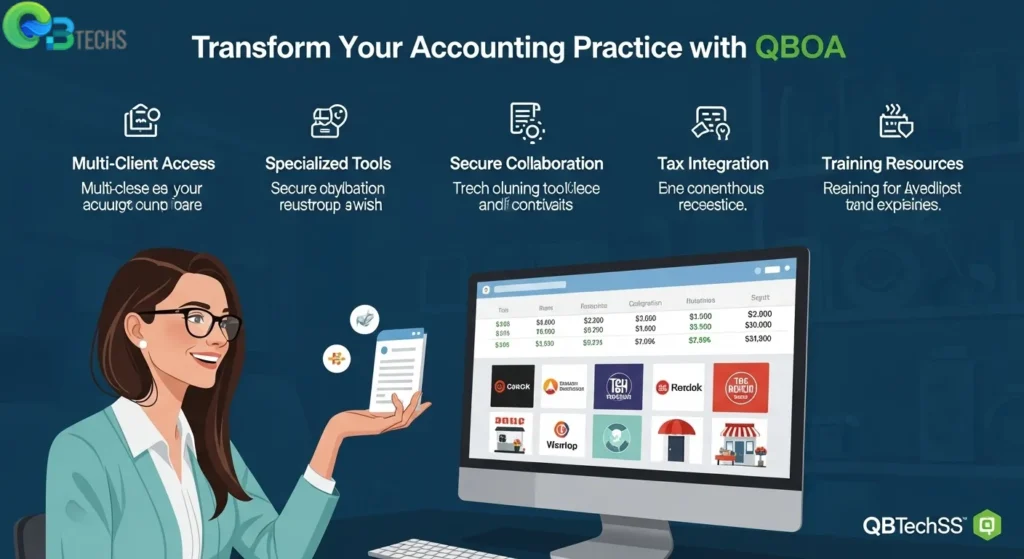
FAQs (Frequently Asked Questions)
What is QuickBooks Online Accountant (QBOA) and who is it designed for?
QuickBooks Online Accountant (QBOA) is a specialized accounting software designed specifically for accounting professionals and firms. It offers tailored tools and features that enhance accounting workflows, improve efficiency, and support bookkeeping and tax preparation tasks.
How does QBOA differ from the standard QuickBooks Online version?
Unlike the standard QuickBooks Online, QBOA provides additional accountant-centric features such as the customized ‘My menu’ with advanced accountant tools, practice management dashboards, client collaboration tools, and integration with ProConnect Tax Online. These enhancements cater to the unique needs of accounting professionals managing multiple clients.
What are some core features of QBOA that improve accounting workflows?
Core features include the ‘My menu’ accountant tools like Prep for Taxes Tool for year-end reviews, Reclassify Transactions for bulk edits, Write Off Invoices functionality to efficiently handle bad debts, Reconcile Tool with reconciliation reset capability, customizable Chart of Accounts templates, split billing options, and comprehensive reporting customization to tailor financial reports to client needs.
How does QBOA support practice management for accounting firms?
QBOA offers a centralized client and project dashboard providing status updates across all clients. It includes secure messaging and document sharing tools for confidential communication. Additionally, it consolidates notes and tracks tasks by due dates to streamline workflow management and accountability within the firm.
Can accountants manage multiple client files simultaneously in QBOA?
Yes, QBOA’s collaboration tools allow accountants to access multiple client files concurrently without logging in or out repeatedly. This multitasking capability enhances productivity and seamless client service delivery.
What training and certification resources are available for QBOA users?
Intuit provides extensive educational materials including webinars and self-paced lessons tailored to QBOA users. Certification programs are also available to help accounting professionals enhance their skills, improve accuracy in bookkeeping and reporting, and maximize the benefits of QBOA’s integrated features.

